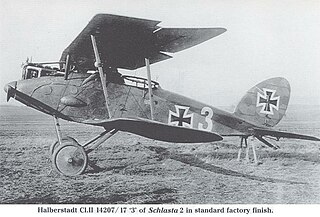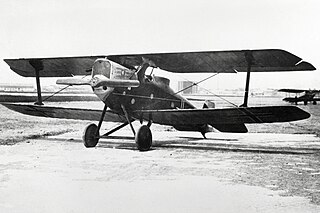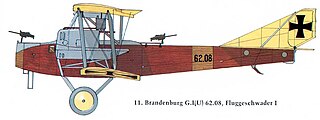
A biplane is a fixed-wing aircraft with two main wings stacked one above the other. The first powered, controlled aeroplane to fly, the Wright Flyer, used a biplane wing arrangement, as did many aircraft in the early years of aviation. While a biplane wing structure has a structural advantage over a monoplane, it produces more drag than a monoplane wing. Improved structural techniques, better materials and higher speeds made the biplane configuration obsolete for most purposes by the late 1930s.

A triplane is a fixed-wing aircraft equipped with three vertically stacked wing planes. Tailplanes and canard foreplanes are not normally included in this count, although they occasionally are.

The AGO C.IV was a First World War German biplane reconnaissance aircraft.

The LFG Roland C.II, usually known as the Walfisch (Whale), was an advanced German reconnaissance aircraft of World War I. It was manufactured by Luft-Fahrzeug-Gesellschaft G.m.b.H.

The Hannover CL.III was a German military aircraft of World War I. It was a two-seat multi-role aircraft, primarily used as a ground attack machine. Like the other Hannover "light-C-class", or "CL" designated aircraft designed by Hermann Dorner, it included an unusual biplane tail, allowing for a greater firing arc for the tail gunner. Until the introduction of the aircraft, such tails had only been used on larger aircraft.

The Caproni Ca.97 was a civil utility aircraft produced in Italy in the late 1920s and early 1930s. As originally designed, it was a high-wing braced trimotor monoplane of conventional configuration with one engine mounted on the nose and the other two carried on strut-mounted nacelles at the fuselage sides. Examples were also produced with only the nose engine or only the two nacelle-mounted engines.

The Hansa-Brandenburg D.I, also known as the KD was a German fighter aircraft of World War I. Despite poor handling characteristics it was put into service by Austria-Hungary, where some aircraft served until the end of the war.

The Halberstadt CL.II was a German two-seat escort fighter/ground attack aircraft of World War I. It served in large numbers with the German Luftstreitkräfte in 1917-18.

The Hannover CL.II was an escort fighter, produced in Germany during World War I, designed in response to a 1917 requirement by the Idflieg for such a machine to protect reconnaissance aircraft over enemy territory. It was a compact biplane of largely conventional configuration with single-bay staggered wings of unequal span. The fuselage was a thin plywood paneled, wooden monocoque design, very similar to the style of fuselage in Robert Thelen's Albatros series of single-seat fighters.

The Hannover CL.V was a biplane ground-attack aircraft built in Germany during World War I, which saw some service and additional production in Norway following the war.
The Hannover F.10 was an early German airliner developed shortly after World War I by Hannoversche Waggonfabrik based on their wartime escort fighters; the Hannover CL.II and its derivatives. Unlike those aircraft, which were all biplane designs, the F.10 was a single-bay triplane, with a middle wing mounted flush with the fuselage top, and a top wing mounted on struts above it. I-struts were used in the interplane gap, as on the Hannover CL.V. The fuselage was essentially similar to its military forebears, but the tail gunner's position was now enclosed as a cabin for two passengers and the wing-mounted radiator was substituted for a frontal radiator. The F.10 also featured the characteristic biplane tail unit that had been developed originally to give the tail gunner a good field of fire.

The Hansa-Brandenburg G.I was a bomber aircraft used to equip the Austro-Hungarian aviation corps in World War I. It was a mostly conventional large, three-bay biplane with staggered wings of slightly unequal span. The pilot and bombardier sat in a large open cockpit at the nose of the aircraft, with a second open cockpit for a gunner in a dorsal position behind the wings. An unusual feature was the placement of the twin tractor engines. While the normal practice of the day was to mount these to the wings, either directly or on struts, the G.I had the engines mounted to the sides of the fuselage on lattices of steel struts. This arrangement added considerable weight to the aircraft and transmitted a lot of vibration to the airframe.

The Hansa-Brandenburg W.13 was a flying boat bomber developed in Germany in 1917 and used by the Austro-Hungarian Navy during World War I.

The Handley Page Type G was a two-seat British biplane, designed by Handley Page that first flew in 1913. Only one was built.
In aviation, a multiplane is a fixed-wing aircraft-configuration featuring multiple wing planes. The wing planes may be stacked one above another, or one behind another, or both in combination. Types having a small number of planes have specific names and are not usually described as multiplanes:
The Gabardini biplane was an Italian single seat biplane, designed and built near the beginning of World War I. It was an advanced trainer and could be fitted with engines of output between about 40 to 80 kW.

The Paalson Type 1, (Pålson), was a Swedish single-seat sport aircraft built around 1920. It was of conventional single-seat biplane layout but had some unusual features such as girder type interplane struts, a novel main undercarriage axle mounting and a mechanism allowing adjustment of the angle of incidence of the upper wing.

The Albatros C.XIV was a German two seat, single engine, biplane fighter aircraft built in 1918. Only one was constructed.
In aeronautics, bracing comprises additional structural members which stiffen the functional airframe to give it rigidity and strength under load. Bracing may be applied both internally and externally, and may take the form of strut, which act in compression or tension as the need arises, and/or wires, which act only in tension.
The Aviatik C.VIII was a prototype German observation aircraft built by Aviatik in World War I.















